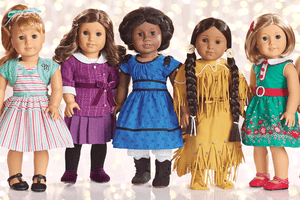Your Best American Girl
The summer after first grade, my mom and I made a deal: If I read 40 books over the summer, I could get an American Girl doll. I went to work right away, and after a dutiful summer of reading, I got one.
As an avid reader on a mission during that summer, I was naturally drawn to the novel series accompanying each historical American Girl doll. My favorite was the Rebecca series about Rebecca Rubin, a fictional Jewish girl living on the Lower East Side in 1914 whose family immigrated to America from Russia. The stories detail Rebecca’s resourceful endeavors to earn money, her passion for acting, her loyalty to her family, and her can-do attitude. I was ecstatic to see a clever Jewish girl reflected in my own favorite media. It wasn’t hard to imagine how I could have been Rebecca had I been alive in 1914.
As I’ve grown, though, I’ve realized that Rebecca, the product, is the very antithesis of everything she meant to me. American Girl packaged her resourceful spunk, flattened and commodified that resilient Jewish spirit into something they could sell and only a privileged few could buy.
Recently, the historical-fiction narratives of American Girl dolls have been nostalgically recast in the public eye with the creation of the American Girls podcast, a book-by-book exploration of the historical and cultural impact of the various series. In a gushing New York Times review, author Margaret Lyons reflects that the podcast “recontextualize[s] the abundant doll joys of [her] youth.”
I have also been recontextualizing my relationship with these stories.
Lyon writes that the podcast has helped her “unpack how the historical doll and book series inspired a creative adulthood.” But as I look back on my doll phase, I realize that I matured into a creative adult in spite of these stories rather than because of them.
I’ve come to see how Rebecca’s narrative is a little too accessible. In retrospect, the whole set-up looks more commercial than empathetic; I feel sort of used. American Girl was capitalizing on Rebecca’s identity, using her relatable allure to sell a doll-sized $36 menorah and dreidel set. (Was the double-chai price tag a coincidence? Of course not.)
Eventually, many of my non-Jewish friends had Rebecca dolls and it felt like everyone had a doll whom they could pretend was cooking latkes with their grandmothers. Rebecca and her stories were no longer just for me, and that American Jewish experience didn’t feel as special, as cherished, as mine.
According to the American Girl website Rebecca “exemplifies the Jewish tradition of helping others.” She inspires girls to imbue their lives with “integrity,” “compassion” and “chutzpah,” which they loosely translate to “confidence.”
Is chutzpah a universally applicable quality? Can young girls learn to go against the grain by reading highly-commercialized mainstream media? Is there anything Jewish about a Jewish doll if her Jewishness is reduced to nothing but expensive accessories and banal adjectives?
If Rebecca were real, she wouldn’t have had an American Girl Doll. She played pretend by acting, with herself as the protagonist. I like to think that Rebecca had actual chutzpah, true, unscripted audacity. No book or doll taught her bravery. Jewish girls in tenements in the early 1900s played their own games—they wrote their own stories. Rebecca had no $70 miniature “Sabbath Set.” Her family was poor. Her parents probably gave her gelt for Hanukkah, surely not a $100 doll. And if we’re going to be honest here, nobody would have had to bribe her to get her to read all summer.
Half a lifetime since my American Girl obsession, I now see how the franchise was hacking away at the very heritage and plucky resourceful attitude it celebrated. When you bought the doll, Rebecca’s words were already written, her accessories already manufactured, her destiny predetermined. Her story followed the same script as all the other dolls’ (make a friend, confront a bully, celebrate a birthday, realize a passion, etc.), except a Hanukkah story was subbed in for the signature Christmas book, of course.
Now, as a young woman who is realizing her own creative potential—who leads a newspaper, builds furniture, paints portraits—I see Rebecca differently. Her ready-to purchase individuality feels more generalizing and insulting than the original flattery I felt at being seen. As I’ve grown, I see this piece of media as a reminder that nobody gets to tell me what an “American Girl” thinks or says or likes or values. We are the American girls. We are not dolls.








Molly, Although I think that your comments are very understandable, I have to take another side in opposition to your thoughts.
For myself, I never had an American girl doll or even a Madame Alexander character doll -- even though it is impossible since the American girl dolls were made well after my childhood, my parents would have probably thought such a doll was way too pricey to purchase.
However, I did have dolls that I absolutely loved playing with. I now have a bright and creative seven year-old granddaughter who loves to play with dolls and play act in general. I just purchased a retired "Rebecca Rubin" doll for her birthday/Chanukah gift.
I am delighted that such a doll even exists! With this gift I can open up a whole discussion with her about immigration and our own family's personal immigration from Eastern Europe in the early 1900s (almost identical to Rebecca's story).
I am pretty sure that there are few others in the entire family (only possibly her other grandmother) who would ever even think to approach the story since they are all way too busy and too taken up with being modern and up to date and also, not really interested in history.
But for me, I have gone over and over in my head what we will talk about and how I will show her family pictures, etc. However, that also doesn't mean that I will succumb to purchasing all the other commercial accessories that (I agree) are way overpriced!
In general, I have found in my own lifetime that most things in life have more than one side--ranges of gray instead of just black and white--even when it comes to American Girl Dolls!
Sincerely Yours,
Helaine Davis
Molly, Your writing abilities are outstanding and the contents inspires contemplation. You've succeeded in sharing your views as a young lady which questions your understanding as a child. This reprocessing of our past is essential in growing and being productive in improving the world. BRAVO!!
Molly, you are so on point. Our lives are filled with others’ preconceived notions of who we are, what we like, what we do. People think they know us from their own preconceived notions. We are all so different, and when audacious, like you are, then we are unique. Thank you for writing to my heart.
Thank you - this is it exactly!